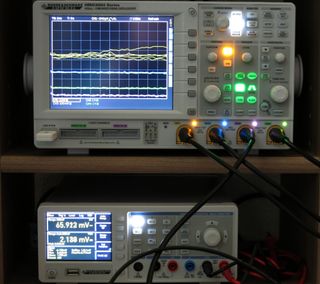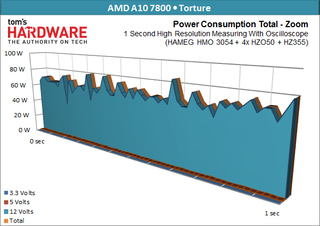AMD A10-7800 APU Review: Kaveri Hits the Efficiency Sweet Spot
AMD recently introduced another model in its A-series APU family called the A10-7800. While we already know a lot about the Kaveri architecture, this particular chip's power profile makes it more interesting than the performance-oriented incarnations.
How We Tested AMD's A10-7800
While we adapted our graphics card test setup for the APU tests, the equipment didn't change. The HAMEG HZO 3054 (Rohde & Schwarz) is the core instrument, a fast four-channel DSO that can be remote-controlled via Ethernet and store up to 60,000 samples per channel.

We run the 12 V wires of the eight-pin (2 x four-pin) CPU power cable through a current probe, as shown in the left picture below, and also the 24-pin cable's 12 V wires (on the right). That makes four HAMEG HZO50 probes to measure the current without having to insert a series resistor into any cable. Simultaneously, each rail’s voltage is fed into a HAMEG HMC8012, which also has the deep storage and remote control options installed.


In order to tame the massive amount of data, we use a custom program and Excel. A measurement takes a full minute, and the sampling interval is 10 ms, which results in 6000 samples. Shrinking the sampling interval further wouldn't yield a tangible benefit, and would instead drown us in test data.
Unsurprisingly, at less than 100 W power draw, platform-oriented benchmarking isn't as wild as some of the graphics card-based results we've seen, and the motherboard doesn’t impose massive load spikes on the PSU. But there are still a few noteworthy observations.
As a preview to the following pages, let’s look at the motherboard's power draw in one second:

Test Setup and Test Equipment:
| Method | Contact-free DC measurement at PCIe slot (using a riser card) Contact-free DC measurement at external auxiliary power supply cable Mass-free Voltage measurement at external auxiliary power supply cable |
|---|---|
| Equipment | 1 x HAMEG HMO 3054, 500 MHz digital multi-channel oscilloscope 4 x HAMEG HZO50 current probes 3 x HAMEG HZ355 (10:1 probes, 500 MHz) 1 x HAMEG HMC 8012 digital multimeter with real-time storage function |
| Test System | MSI A88XM Socket FM2+ AMD Radeon Memory Corsair H100i Closed-Loop Water Cooler Corsair Neutron 480 GB SSD SeaSonic X-Series PSU |
Stay on the Cutting Edge
Join the experts who read Tom's Hardware for the inside track on enthusiast PC tech news — and have for over 25 years. We'll send breaking news and in-depth reviews of CPUs, GPUs, AI, maker hardware and more straight to your inbox.
Current page: How We Tested AMD's A10-7800
Prev Page APU, Motherboard and Memory Next Page Results: CPU-
blackmagnum Just to wonder if Microsoft or Sony were to put this chip in their next gaming consoles and give those gamers a fighting chance.Reply -
tiger15 You are stressing power efficiency.Reply
What about comparing those numbers with other offerings? (Intel?) -
Memnarchon Reply13989815 said:Just to wonder if Microsoft or Sony were to put this chip in their next gaming consoles and give those gamers a fighting chance.
Maybe the new consoles lack CPU power (even if they are 8 core, the 1,6Ghz/1,75Ghz cripples them), their GPU part is far more powerful than existing APUs.
PS4's GPU has cores like 7870 and XBOX1 has cores like 7790, in other words more powerful than the 512 core R7 which exists in today's best APU A10-7850K. -
Cryio Wait. You can now CrossFire A10 7850 with GPUs other than the 240 and 250X?Reply
I have a friend with a 7850K and a 260X and he's dying to know if he can CrossFire.
"I see no point in buying a processor that emphasizes on-die graphics and then adding a Radeon R7 265X. Yes, AMD officially recommends it and yes, we tried it out." Can I take this as a yes ? -
gadgety The A8-7600 seems to be the effiency sweet spot in the Kaveri line up, specially at 45W. Trying to compare with of the A10-7800 with the A8-7600, although as far as I can tell just about ALL your tests seem to be done at different settings (e.g. BioShock Infinity is run at Medium Quality Presets rather than the lowest settings as in the test of the A10-7800) so the comparison isn't straightforward. A8-7600 is within 91-94% of the A10-7850K. One item which is comparable is video encoding in Handbrake, where the A8-7600 is at 92.8% of the 7850k, whereas the A10-7800 is at 95.7% of the 7850k. Price wise you'd pay a 63% premium for the A10-7800 over the A8-7600 to get an extremely minute performance advantage, around 3% or so.Reply -
Drejeck Reply
Not accurate.13989815 said:Just to wonder if Microsoft or Sony were to put this chip in their next gaming consoles and give those gamers a fighting chance.
Maybe the new consoles lack CPU power (even if they are 8 core, the 1,6Ghz/1,75Ghz cripples them), their GPU part is far more powerful than existing APUs.
PS4's GPU has cores like 7870 and XBOX1 has cores like 7790, in other words more powerful than the 512 core R7 which exists in today's best APU A10-7850K.
PS4 GPU is a crippled and downclocked 7850 (disabled cores enhance redundancy and less dead chips)
XB1 GPU is a crippled and downclocked R7 260X (as above) and like the 7790 should have AMD True Audio onboard, but they could have changed that. This actually means that CPU intensive and low resolution games are going to suck because the 8 cores are just Jaguar netbook processors.
The reality is that PS4 is almost cpu limited already and the XB1 is more balanced. Now that we've finished speaking of "sufficient" platforms let's talk about the fact that a CPU from AMD and the word efficient are in the same phrase. -
Memnarchon Reply
I think you need to do a little more research since: Reverse engineered PS4 APU reveals the console’s real CPU and GPU specs. "Die size on the chip is 328 mm sq, and the GPU actually contains 20 compute units — not the 18 that are specified. This is likely a yield-boosting measure, but it also means AMD implemented a full HD 7870 in silicon."13990605 said:Not accurate.
PS4 GPU is a crippled and downclocked 7850 (disabled cores enhance redundancy and less dead chips)
13990605 said:XB1 GPU is a crippled and downclocked R7 260X (as above) and like the 7790 should have AMD True Audio onboard, but they could have changed that. This actually means that CPU intensive and low resolution games are going to suck because the 8 cores are just Jaguar netbook processors.
The reality is that PS4 is almost cpu limited already and the XB1 is more balanced. Now that we've finished speaking of "sufficient" platforms let's talk about the fact that a CPU from AMD and the word efficient are in the same phrase.
The PS4 will be CPU limited? Since they write the code/API according to a hardware that it will remain the same for like 7-8 years, such thing as CPU limited especially for a console that runs the majority of games at 1080p, does not exist...
ps: I agree with the downclocked part since they need to save as much power as they can... -
blubbey Reply
Not accurate.13989815 said:Just to wonder if Microsoft or Sony were to put this chip in their next gaming consoles and give those gamers a fighting chance.
Maybe the new consoles lack CPU power (even if they are 8 core, the 1,6Ghz/1,75Ghz cripples them), their GPU part is far more powerful than existing APUs.
PS4's GPU has cores like 7870 and XBOX1 has cores like 7790, in other words more powerful than the 512 core R7 which exists in today's best APU A10-7850K.
PS4 GPU is a crippled and downclocked 7850 (disabled cores enhance redundancy and less dead chips)
XB1 GPU is a crippled and downclocked R7 260X (as above) and like the 7790 should have AMD True Audio onboard, but they could have changed that. This actually means that CPU intensive and low resolution games are going to suck because the 8 cores are just Jaguar netbook processors.
The reality is that PS4 is almost cpu limited already and the XB1 is more balanced. Now that we've finished speaking of "sufficient" platforms let's talk about the fact that a CPU from AMD and the word efficient are in the same phrase.
PS4 is 1152:72:32 at 800MHz, 7850 is 1024:64:32@ 900MHz or so (860MHz release?) It is not a "crippled 7850", the 7850 is a crippled pitcairn (20 CUs is the full fat 7870, PS4 has 18, 7850 16 CUs). "CPU limited" is very PC orientated thinking, things like offloading compute to the GPU will help. No, I'm not saying their CPUs are "good" but they will find ways of offloading that work onto the GPU. -
silverblue ReplyThe A8-7600 seems to be the effiency sweet spot in the Kaveri line up, specially at 45W. Trying to compare with of the A10-7800 with the A8-7600, although as far as I can tell just about ALL your tests seem to be done at different settings (e.g. BioShock Infinity is run at Medium Quality Presets rather than the lowest settings as in the test of the A10-7800) so the comparison isn't straightforward. A8-7600 is within 91-94% of the A10-7850K. One item which is comparable is video encoding in Handbrake, where the A8-7600 is at 92.8% of the 7850k, whereas the A10-7800 is at 95.7% of the 7850k. Price wise you'd pay a 63% premium for the A10-7800 over the A8-7600 to get an extremely minute performance advantage, around 3% or so.
Yes, but the A8-7600 has a 384-shader GPU. I suppose it depends on whether you want to use the GPU or not.
Most Popular

